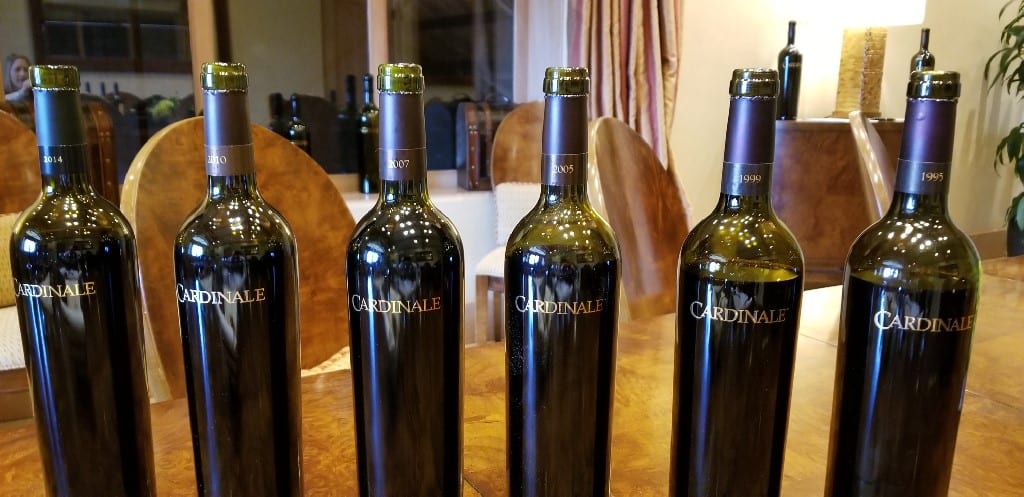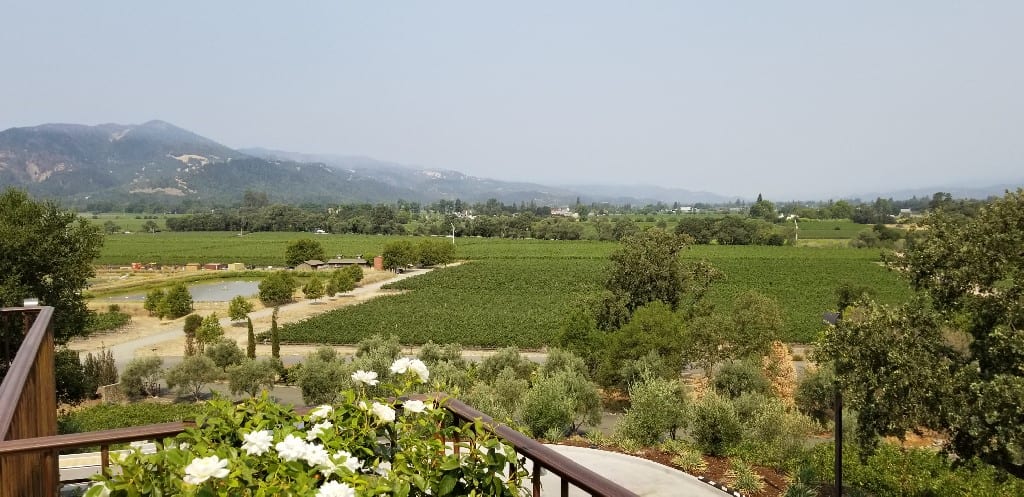
25 Oct A Vertical Tasting of Napa Valley Mountain Cabernet Sauvignon
There are challenges to planting vines on the mountains but there are many advantages as well. My recent story in the Napa Valley Register, which you can read below, is about Cardinale Winery, who focuses on a single Cabernet Sauvignon that is a blend from four mountain vineyards. Each vineyard contributes different characteristics to make the elegant wine year after year.
When mountains were created millions of years ago, volcanic eruptions resulted in extrusive and intrusive lava soils. These mountains were less fertile, and it was realized long ago that food crops and orchards thrived off the fertile land of the flats.
But up on the angled slopes of the mountains, some winemakers found a perfect location for vineyards. The Napa Valley produces four percent of California’s wine, yet only five percent of Napa’s wine production comes from mountain fruit. One of these wineries is Cardinale.
Cardinale was created in 1982 with the mission to produce Cabernet Sauvignon from the highest-quality vineyards throughout the North Coast. By 1995, the wine was made from predominately mountain fruit from Napa and Sonoma vineyards, and by 2002, the wine was made from 100 percent Napa Valley vineyards. Today, the final blend is made from exclusively mountain fruit from Mount Veeder, Howell Mountain, Spring Mountain and Diamond Mountain.
Growing grapes on the mountains has some challenges. For one thing, mechanization is not possible so there is the cost of hand-picking. Growing on the mountains can cause some fear, such as fear of not ripening and fear of not handling the tannins.
There is the economic pressure as mountain vineyards do not produce high yields.
Finally, there are the expectations around flavor as many people want big, lush, ripe wines and that is not what mountainous fruit produces.
But there are advantages to planting on a mountainside. Gilian Handelman, director of wine education for Jackson Family Wines, explained some of the benefits of growing grapes on mountains.
Weather: When you are at 1,400 feet elevation, you are above the fog line. The result is that the sun exposure is more intense, resulting in the grapes forming a thick skin to protect them from the sun. The exposure to the sun may be more intense and good for ripening, but heat exposure is less. In addition, rainfall does not collect because the vines are on an angle and the rain runs down the mountain.
Soil: There are two soil types found in the mountains, extrusive and intrusive volcanic soils and a mix of sedimentary, metamorphic ocean soils.
Environment: On the mountainsides, soil vigor is low. Silt blows down the mountain and all that is left is parent rock. There is also not a lot of groundwater. In addition, you cannot eliminate the flora at elevation, and that means there are trees surrounding the vineyards.
Vines: Mountain fruit provides lower yields and smaller berries. And there is very low disease pressure as botrytis thrives in wet climates. In addition, typically phylloxera did not attack mountain vines so many of them are own-rooted.
For 35 years, Cardinale has been focused on mountain fruit, working with four vineyard sites along the Mayacamas Mountains and the Vaca Mountains.
Mt. Veeder consists of more rocks, and therefore, more drainage, and the wines produced have notes of bell pepper and blueberry skin and are the apex of tannin. The high elevation and deep topsoil of Spring Mountain produces a fruit-forward wine. The black lava rock of Diamond Mountain and heat of Calistoga result in a wine with intense fruit. And, Howell Mountain, with its red and white compressed volcanic ash and intense sun exposure, results in more consistent growth with higher yields and fruit-driven wines.
I enjoyed a retrospective tasting recently of Cardinale wines, going back more than 20 years. This tasting offered a liquid diary of the influence from each mountain vineyard and demonstrated how wines from mountain vineyards get better and better with age.
Cardinale 1999 Cabernet Sauvignon – A dense and opulent wine with aromas of blueberry, blackberry, tobacco and cedar and sandy tannins that cover the tongue.
Cardinale 2005 Napa Valley Cabernet Sauvignon – Floral aromas as well as notes of black cherry cassis and anise are present in this wine that has silky tannins and has many more years of life left.
Cardinale 2007 Napa Valley Cabernet Sauvignon – Considered a perfect year, this wine is very pretty with aromas of fruit, graphite and anise and velvety tannins.
Cardinale 2010 Napa Valley Cabernet Sauvignon – Considered one of the coolest vintages ever, the wine has notes of bell pepper, dark cherry and spice and grippy tannins.
Cardinale 2014 Napa Valley Cabernet Sauvignon – While still young, this structured wine has floral and red and purple fruit aromas and drying elegant tannins.
Read the original story in the Napa Valley Register.
Discover more from Please The Palate
Subscribe to get the latest posts sent to your email.




